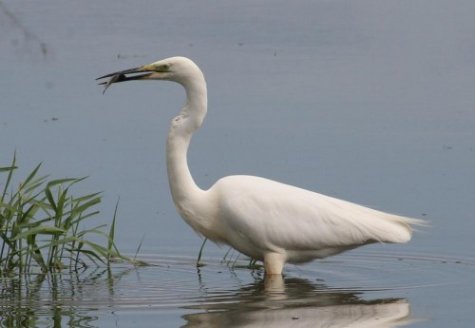Birder's diary - 30.-31.08
Birder Margus Ots, Linnuvaatleja.ee
Translation: Liis
August 30
In early morning I stayed to observe birds for a couple of hours at the former Lao bird station in Pärnumaa. The narrow southerly-extending cape here gathers large numbers of passerines and birds of prey at the autumn migration. Nearby at the southern tip of Kihnu island a thorough bird migration monitoring project goes on (for more details see the project blog) and for comparison it is interesting to know what happens at Lao. Unfortunately much movement was not to be seen. The most interesting observation came at sunrise – at least 38 great egrets (Egretta alba) rose into flight from the reed banks. In August great egrets have been seen in great numbers all over Estonia. Mainly in the Pärnumaa shore areas but also in Tartumaa, Lääänemaa and Saaremaa altogether at least 400 great egrets have been around. Why and from where do they come to Estonia now at summers end?
Great egret (31.05.2012 Valguta polder)
On the road back to Tartu I checked the ploughed fields. End of August and early September is a time when the rare passing migrant Eurasian dotterel (Charadrius morinellus) might be found on ploughed fields among lapwings (Vanellus vanellus) and golden plovers (Pluvialis apricaria).According to information at the Bird rarities committee the golden plover has been observed in Estonia on about 30 occasions. Evidently it is a more frequent visitor here than might be deduced from the few observations, because this bird on migration stops on ploughed fields where it is difficult to notice it. Lapwings were quite numerous in the fields in several places, ruffs, but fewer, were also to be seen. The looked-for bird did not appear to be there but better times are still to come.
August 31
In the last few days I have noticed great numbers of nutcrackers (Nucifraga caryocatactes) – at Cape Põõsaspea altogether 59 and in Laos 44 birds. If I remember correctly these birds haven’t been seen in such great numbers earlier. Is a mass invasion year to come? If there are many nutcrackers on the western coast then they should be seen moving about at Lake Peipsi too for instance. So in early morning I went to Mehikoorma. Here is the narrowest spot (ca 2 km) of the Lämmijärve lake and from the other side, at Pnevo peninsula, millions of passerines start off to cross the lake on the autumn migration. To my great surprise at once at sunrise a great milling about got loose – during a few hours nearly 40 000 birds crossed the lake. Such a view I would rather have expected in the second half of September, not in August. But actually maybe nobody has been telescoping here in August before, maybe this is a normal sight? Of this great mass of birds some 35 000 remained unidentified because from a distance of 2 km it isn’t possible to identify the species. Simply “small passerine” will be noted, among whom evidently now also were large numbers of pipits and wagtails, but also already finches and tits. Swallows on migration were about 3000. Some ten nutcrackers (Nucifraga caryocatactes) came across the lake, however already about 160 jays (Garrulus glandarius), this number I would rather have expected in the latter half of September. Birds of prey were comparatively few, only some sparrowhawks (Accipiter nisus), buzzards (Buteo buteo) and hobbies (Falco subbuteo)came from Russia to Estonia. Among the migrants were also some ten greater spotted woodpeckers (Dendrocopos major), and surprisingly 3 black woodpeckers (Dryocopus martius)crossed the lake too; they are not particularly eager migrants. At Mehikoorma too, that is at Cape Pnevo, great egrets could be seen, 6 birds in the largest flock. Anyone who takes pleasure in counting specks in the sky I recommend going to Mehikoorma to telescope. Plans in September and October are to observe the migration there more in detail. Observations from last year can be seen in the e-Biodiversity database.
(Estonian original published 01.09.2012)









